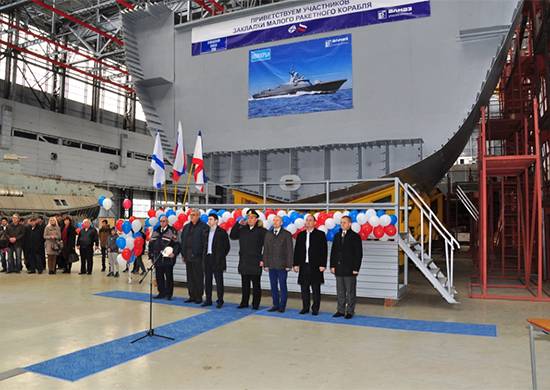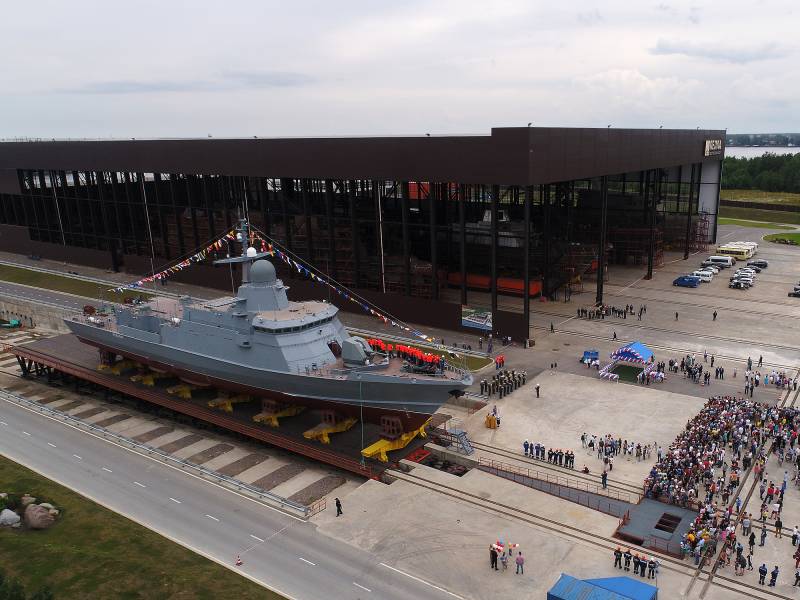Project 22800 "Karakurt". Laid the next ship
According to the press service of the Russian Ministry of Defense, on December 19, in one of the workshops of the More shipyard (Feodosia), a new small missile ship (MRK) of project 22800 was laid solemnly in accordance with the order of the Navy Commander-in-Chief Admiral Vladimir Korolev, the new ship was given the name "Whirlwind", which continues the peculiar tradition of naming new RTOs. The ceremony was attended by representatives of the Ministry of Defense and fleet, the management of the factory "More", the delegation of the Feodosia leadership, as well as shipbuilders and veterans.
In accordance with the current plans of the Ministry of Defense, over the next few years, the navy will have to receive almost two dozen small rocket ships of the Karakurt type. Earlier it was reported that the construction of such IRCs will be carried out by four shipyards in different parts of the country. One of the performers of the order was the factory "More" in Feodosia. Part of the production capacity of this company was previously transferred to the Leningrad Shipbuilding Plant "Pella", which, as expected, would increase the efficiency of work and speed up order fulfillment.

Currently, there are eight 22800 project ISCs in the Pella plant order portfolio. Half of these ships will be built on the platform in Otradnoe, the other four - in Feodosia. It should be noted that the “More” plant is currently building three out of four “Karakurt”, which it is to pass. In the foreseeable future, a solemn laying of the fourth ship will take place. In addition, the delivery of the first ISC, built in the Crimea, is not far off.
In May 2016 of the year at the shipyard "More" in Feodosia took place the laying of a small rocket ship with the name "Storm" and serial number 254. This is the third ship of the project 22800 and the second serial. For the Crimean plant, in turn, “Storm” is the first under the new order. According to known data, this ship will have to be completed, tested and handed over to the fleet in the next 2018 year.
The next bookmark ceremony "Karakurt" was held in mid-March this year. The ship with the serial number 255 was given the name Okhotsk. The second for the “Sea” and the sixth in the series of ISCs will have to be part of the Navy no later than 2019-20. Just the other day, an official start was given to the construction of the Whirlwind ship, the third for the Feodosia enterprise.
According to reports, the Leningrad Shipbuilding Plant "Pella", manager of the production capacity of the "Sea", already has plans to build another small rocket ship. Soon in Feodosia, the laying of the next "Karakurt" will take place. As the press reports, this ship can get the name "Cyclone", continuing the current "meteorological" tradition. Its construction should be completed no later than the beginning of the twenties.
As you can see, the situation with the construction of ships of the 22800 project at the Sea plant in Feodosiya may be a reason for optimism. There are orders for four rocket ships, of which three are already at different stages of construction, and the fourth will be laid in the very near future. At the same time, not one of the Crimean "Karakurts" has yet been launched, but judging by the last newsSuch events will not be long in coming.
The Pella plant, which has two sites in different regions, currently plays a key role in the construction of promising small rocket ships. He has to build eight "Karakurts" and at the moment, as far as is known, he is coping with the tasks set. Two ships (the head "Hurricane" and the first serial "Typhoon") were launched this year. Five more - “Storm”, “Squall”, “Storm”, “Okhotsk” and “Whirlwind” - are on the stocks at different stages of construction. In the near future, the laying of the eighth ship.
It is also planned to involve two other enterprises in the construction of small rocket ships of the 22800 "Karakurt" project. Not so long ago it became known that the Zelenodolsk plant them. A.M. Gorky received an order for the construction of five rocket ships. Two of them were laid last year and are currently being built. Information about the construction of three other "Karakurts" has not yet been published. The fact that the laying of the ships "Monsoon" and "Passat" became known only in 2017-m from the report of the plant for the previous year, suggests that the latter could already lay the new ships. However, such information has not yet been confirmed and does not have direct refutations.
To complete the plans for the construction of a relatively large series of warships, a contract for another five or six Karakurts is necessary. According to previously published data, in the near future there will be an order for six such ships. They are supposed to be transferred to the Pacific Fleet, and therefore construction will be carried out at the minimum possible distance from future bases. It is known that the order will have to get the Amur Shipbuilding Plant (Komsomolsk-on-Amur). Currently, the military and industry are discussing the terms of such an agreement.
In the summer of this year, it was announced that the contract with the Amur plant will appear in 2018. Soon after this, the first of the ships of the new series will be laid. The construction of the six "Karakurtov" will take several years and will be completed no later than 2022-23. With the delivery of the last Amur ship, the current plans for the construction of the new 22800 project IRCs will be fully implemented. Will the construction of new rocket ships continue after that or will other projects replace them in the series - it’s too early to say.
Of the nearly two dozen small rocket ships at least two will be transferred to the Baltic Fleet. According to various sources, the lead ship “Uragan” and the first serial “Typhoon” can be sent to the Baltic. However, there is also other information according to which these ships will be included in the combat strength of the Black Sea Fleet. Anyway, the main task of the Pella and Sea factories, apparently, is the renewal of ship connections in the Baltic and Black Seas.
Where the Passat, Monsoon and the three other ships built in Zelenodolsk will serve is also not completely clear. Relative clarity is present only in the case of the six “Karakurts”, which will be built in the future by the Amur Shipbuilding Plant. The transfer of these ships to any operational-strategic alliance of the Russian Navy, with the exception of the Pacific Fleet, is associated with many different difficulties and is simply inexpedient.
Nevertheless, the transfer of new ships to future operators is still a matter of the future. 9 small rocket ships from the 13 ordered are at different stages of construction, and only two of them have been launched to date. Construction of "Karakurtov" is at a record pace, but the ships are not yet ready for delivery to the customer. However, the first acceptance certificate of the 22800 project ship will be signed next year, and after that similar events will occur with enviable regularity until the beginning of the next decade.
***
The project of a promising ship with a developed rocket and artillery armament was developed by the Almaz Central Maritime Design Bureau (St. Petersburg). At the stage of formation of the new type of MRK requirements, they were considered as an addition to the ships of the 21631 "Buyan-M" project, suitable for use in other conditions. Small rocket ships of the 22800 "Karakurt" project, according to the information of the Ministry of Defense and the developer organization, are intended for conducting combat operations in the near sea zone, as well as for carrying out some peacetime tasks.
"Karakurt" to some extent similar to the ship "Buyan-M", however, has noticeable differences of one kind or another. The 22800 project provides for the construction of a ship with a length of 67 m and a maximum width of 11 m with a draft of 4 m. The displacement of such a ship is 800 tons. The power plant consists of M-507D-1 diesel engines and DGAS-315 diesel generators. According to reports, the 22800 IRAs will be able to reach speeds up to 30 nodes. Cruising range with economical fuel consumption will reach 2500 miles. Supply autonomy - 15 days.
The basis of on-board radio-electronic systems is the combat information and control system "Sigma-E". It is linked to the Mineral-M radar observation station and various fire control equipment from all types of weapons. It also provides for the use of electronic warfare, communications systems, etc.
Despite the relatively small size, a rocket ship of the "Karakurt" type must carry a developed armament of various classes and types. The main percussion vehicle of the ship are the Onyx or Caliber missiles, used with the universal vertical launcher 3C14. Ammunition consists of eight missiles. Surface, coastal or air targets can also be attacked with an AK-176MA artillery launcher with a 76-mm automatic cannon.
To protect against air strikes, 22800 project MRKs may receive different weapon. The first version of the project proposed to mount on board AK-630 artillery systems with 30-mm anti-aircraft guns, as well as to use portable anti-aircraft missile systems. Starting from the third ship of the series, "Karakurt" will be equipped with the Pantsir-M missile-cannon complex, capable of solving the same tasks, but having greater potential in certain situations. A relatively powerful artillery armament is complemented by a pair of installations with large-caliber machine guns.
According to official data, when designing new small rocket ships, certain solutions and approaches were used to gain certain advantages. Thanks to this, the ship, despite its relatively small size, is distinguished not only by high maneuverability, but also by good seaworthiness. The architecture of the hull and superstructure was formed with a view to reducing the visibility for all existing detection tools. Reduced reflection of the probing signals of the enemy radar. The reflection of electromagnetic radiation is mainly away from the source.
The IRAs of the 22800 “Karakurt” project - having a relatively small size and displacement - carry a developed armament complex, which includes powerful strike weapons with a long range. The characteristic road performance and weapon parameters make such ships a unique means of solving combat missions in the near-sea zone. Being close to the coast, such ships are able to control large areas and large land areas, as well as to strike at surface or land targets.
A few days ago, the Russian shipbuilding industry began to build the next ship of the Karakurt type. In the meantime, the first representatives of this project are already being completed near the wall and in the near future will have to go to the test. According to the well-known plans of the industry and the Ministry of Defense, the lead ship under the name "Hurricane" will be accepted for service as early as 2018. Then, over the course of several years, it will be followed by the remaining RTOs, which have already been ordered or are only planned to be ordered. Thus, each ceremony, similar to the one that took place last Tuesday, is an important event in the life of the fleet and directly contributes to its speedy rearmament.
On the materials of the sites:
https://function.mil.ru/
http://tass.ru/
http://ria.ru/
http://rg.ru/
http://pellaship.ru/
- Ryabov Kirill
- Ministry of Defense of the Russian Federation / mil.ru, "Pella" / pellaship.ru

Information